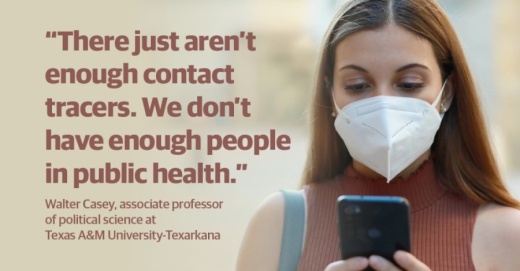But even as Texas moves towards a more centralized system of managing its contact tracing, some experts say these efforts still will not be enough.
“I would make an argument there is an insufficient amount of time, money and personnel devoted to this,” said Walter Casey, associate professor of political science at Texas A&M University-Texarkana, who also works for the Texas A&M Emergency Management Advisory Group and has expertise in trend forecasting statistical modelling.
Test, trace and treat
Contact tracing begins with a COVID-19 case investigation, or contacting a known infected person and identifying who he or she may have been in contact with. These individuals are then contacted to warn them of potential exposure, Chris Van Deusen, director of media relations for the Texas Department of State Health and Human Services, said in an email.
Touted by health experts and officials, contact tracing is the second step of a three-pronged approach to understanding and containing coronavirus: Test, trace and treat.
In Texas, local health authorities were initially tasked with handling their own contact tracing and case investigations, said Angela Clendenin, an instructional assistant professor in the Department of Epidemiology and Biostatistics at Texas A&M University.
The Houston Health Department, for example, repurposed its staff and employed 45 contact tracers in early May, bringing the total number of contract tracers to 125. Others, such as UT Health Austin, brought on volunteers to assist with contact tracing efforts in March.
Rachel Clear, a volunteer with UT Health Austin, said when she was initially brought on board, there was not a lot of work to do. But as cases began to rise—Travis County surpassed 16,000 total cases on July 15, with more than 40% of those cases reported in July—Clear said so did her workload.
"The surge of cases has been difficult for us in terms of workload," Clear said. "That's definitely been a new difficulty we've encountered in the past few weeks."
Statewide, total reported cases reached 332,434 on July 20, according to the Department of State Health and Human Services. Total cases increased by 58,101 from July 6-12; 10,127 from June 6-12; and 6,626 from May 6-12. These numbers do not include probable cases.
The state had been anticipating an uptick in cases, which is why it launched a centralized database known as Texas Health Trace, Clendenin said. The system uploads coronavirus case and contact tracing data at the county level into a statewide management system. Cases and contacts could be entered into the system beginning May 1, according to the Texas Health Trace website.
The initial plan was to have 4,000 contact tracers as part of Texas Health Trace, Van Deusen said. As of July 13, there are 3,100 working in Texas between the local health departments, regional offices and the DSHS virtual call center, he said.
“The call center has been able to handle its workload with capacity remaining to continue to assist local health entities that would like assistance. Both we and the local health departments continue to add staff,” he said.
But some local entities are reporting a backlog of cases, and Casey said finding more workers could be difficult as cases ramp up.
“There just aren’t enough contact tracers. We don’t have enough people in public health,” he said. Centralized effort
Despite the state’s efforts to centralize its database, local health departments are still taking different approaches to contact tracing.
County health departments were given three options regarding the Texas Health Trace system, Van Deusen said. Local entities could either do their own case interviews with the state’s call center doing the contact tracing; assign all case interviews and contact tracing to the state; or continue handling both components themselves.
The data is still supposed to be sent to the state regardless which option county health departments select.
According to the DSHS website, Texas needed a “unified approach” to case investigations and contact tracing.
In a list Community Impact Newspaper obtained through DSHS, Collin County was the only local health entity to have chosen DSHS to conduct both case investigations and contact tracing as of early July, and the majority of counties opted to continue managing both. The list showed all the local health entities in Texas, and any areas not shown are served by DSHS’ regional offices, which are generally doing their own case investigations with the call center doing the contact tracing, Van Deusen said.
Casey said he believes all counties should be required to let the state handle contact tracing and case interviews.
“I think there is a tremendous disadvantage to not having a centralized approach,” Casey said. “For someone like me crunching numbers on a daily basis, if you’re only in part way, we’re only getting part of the information.”
Officials with Collin County opted in to the state program because it would not cost any money and because its health care staff was reaching its limits, Tim Wyatt, the county’s public information officer, said in an email.
Commissioners had debated opting in or out at length at a May 29 Commissioners Court meeting.
“I don’t want us to look back and think about the millions of dollars we spent ourselves staffing and doing software development when something was already being spent by the state to do it,” Precinct 3 Commissioner Darrell Hale said.
Entities that chose to manage contact tracing and case investigations locally include Austin Public Health, Fort Bend County Department of Health and Human Services, and Montgomery County Public Health District. MCPHD Public Information Officer Misti Willingham said in an email she believes the current system is working “very well.”
MCPHD has an electronic system similar to the Texas Health Trace system, Willingham said.
“We have taken the state forms and have them electronic,” she said. “We will import our data into THT.”
Willingham said the district is funded by multiple state and federal grants. MCPHD has six staff members performing contact investigations as well as two additional DSHS contract workers.
However, MCPHD is among the counties that do not report their case counts on the weekends, and on July 15, the entity announced that in the past few weeks, the number of cases have been increasing beyond the capabilities of its public health staff, creating a backlog.
“In an effort to be able to handle the increased volume of contact investigations, we would like to thank Montgomery County Judge Mark Keough, who has offered additional staff from the County and funds from the CARES Act to pay overtime to public health employees,” Willingham said.
Casey said counties that are not reporting weekend case counts and have a backlog of cases could “tremendously hamper public health efforts.”
Nearing capacity
As cases rise, so does the workload and the demand for more contact tracers, Casey said. As of July 9, there were dozens of job and volunteer postings for contract tracers in Texas posted on Indeed.com, with some such as Alta Staff, a staffing agency, “urgently hiring” for 13-week contracts.
To illustrate how time-consuming contact tracing can be, Clendenin, who assists with contact tracing efforts in Brazos County, said she had three cases that had 12 or more contacts. Every one of those contacts had to be called.
In Houston, public health officials are looking at rolling 7-day averages to determine how workloads are affected.
From July 14-20, Harris County reported an average of 1,389 new cases, according to Harris County Public Health.
"It's much easier when you’ve got 300 cases. Its far more difficult when you have 1,500,” Houston Mayor Sylvester Turner said. “You need thousands of people to effectively do that. We really need to get to the point where we’re talking about 300 or less over a 7-day period to get where we need to be."
Meanwhile, a spokesperson with the Harris County Public Health said the department currently has 300 contact tracers and can handle the capacity.
Even as some health officials say they are on top of the workload, Casey said there could still come a point where the volume of cases far outweighs the available labor, particularly in densely populated cities.
“The question still remains—when does this become impossible?” he said.
Casey said epidemiologists estimate that point is when about 2% of population is infected—which in Texas’ case would be about 700,000-800,000 people, he said. On July 20, the total reported case count in Texas was 332,434, according to the DSHS.
“You would reach the point in any sort of dense urban area where contact tracing would become more than an overtime job. You’d be putting in 60 to 70 hours a week just calling people,” he said.
When asked if at that point contact tracing would become moot or if the state would need to direct more resources into contact tracing, Casey said he believes the answer would be to “double down” on its efforts.
Not answering the call
Besides increasing workloads, Casey said contact tracers are also challenged by people simply not answering their phones.
“That is the biggest factor that is hurting contact tracers across the nation, and we are seeing some of that starting in Texas,” he said. “If the phone rings, answer it.”
However, some residents are reporting not even being contacted by a contact tracer though they had a positive test, and some are reporting late results for their COVID-19 tests—meaning they would not know if they had COVID-19 and may not be quarantined. In a questionnaire sent by Community Impact Newspaper, some residents of Montgomery, Harris and Travis counties reported it taking days to over a week to get results back.
Jessica Gonzalez, who lives in Montgomery County, said she scheduled a testing appointment in her home county but the earliest availability was two days later. Instead, she chose to get tested at a CVS in Harris County, which had a same-day appointment June 19.
Gonzalez said she did not get results until June 27, and it was positive.
“It ... took forever to get the results that I already knew,” she wrote in a Facebook message. “[I] just needed confirmation so that I can get paid for the time off.”
As of July 10, Gonzalez said to her knowledge, she has not been contacted by a contact tracer or anyone requesting follow-up information from her.
Jack Flagler and Emma Whalen contributed to this report.





